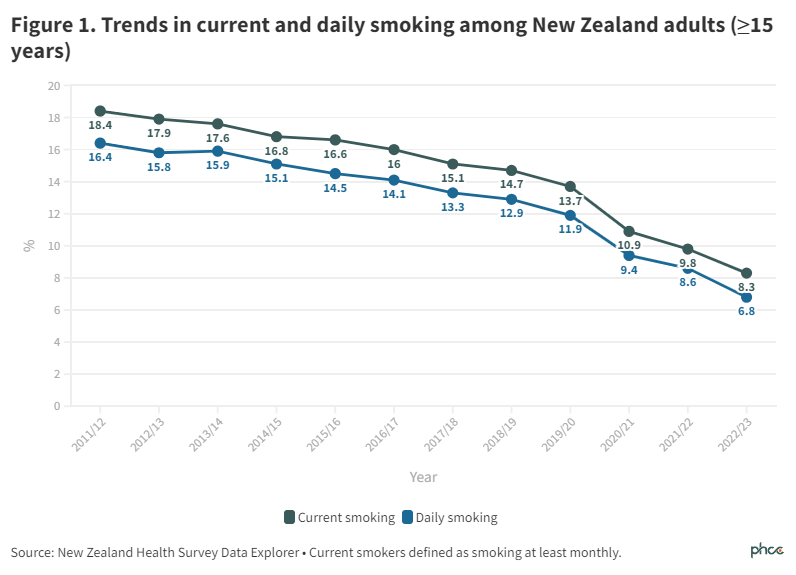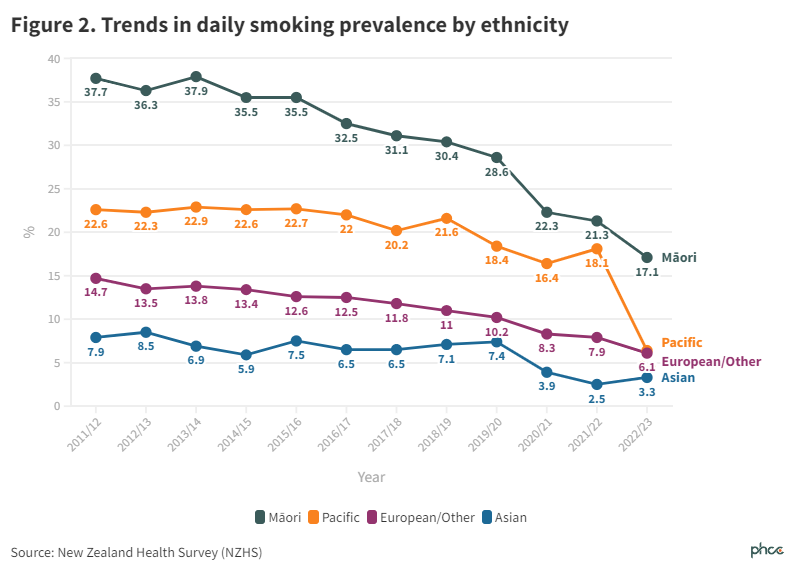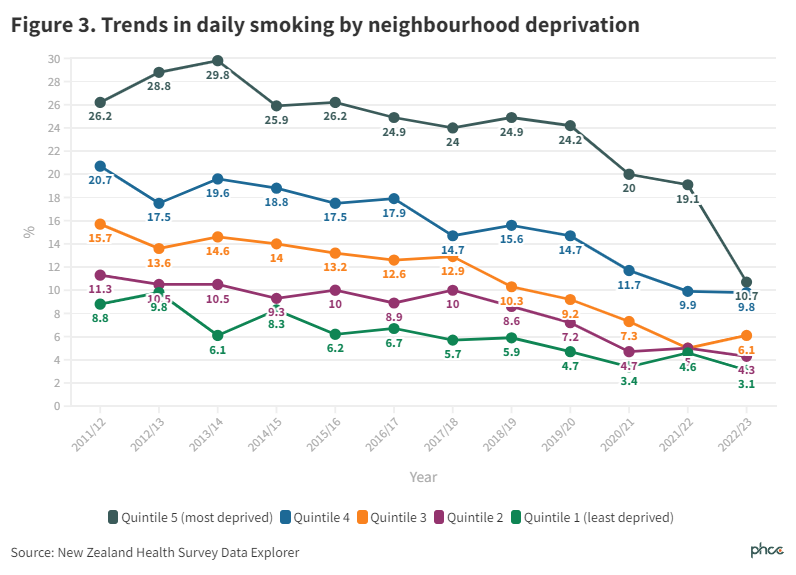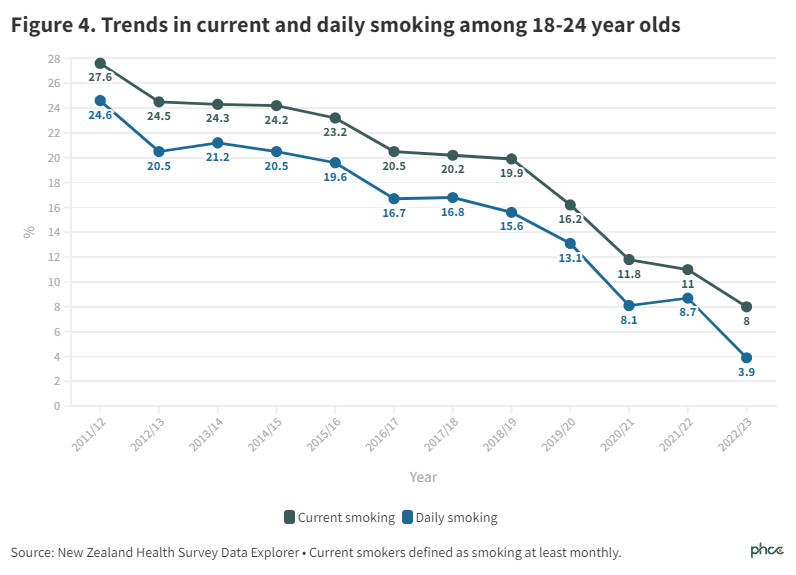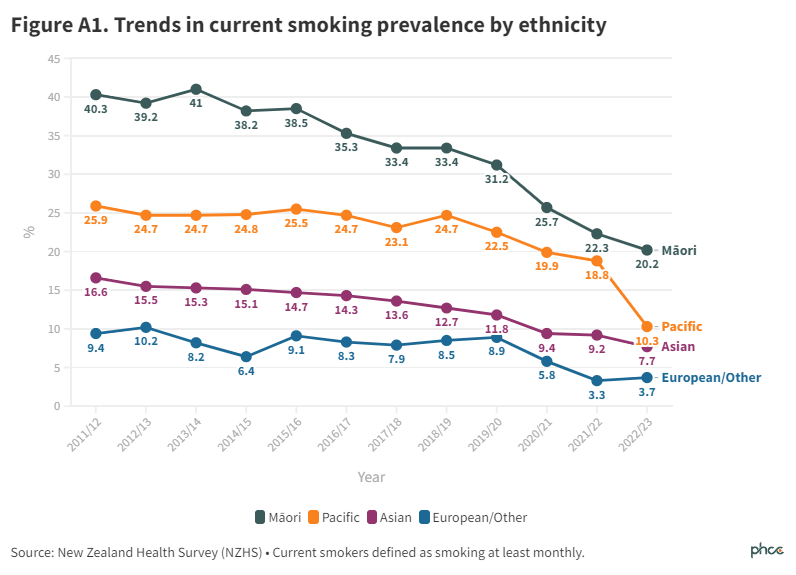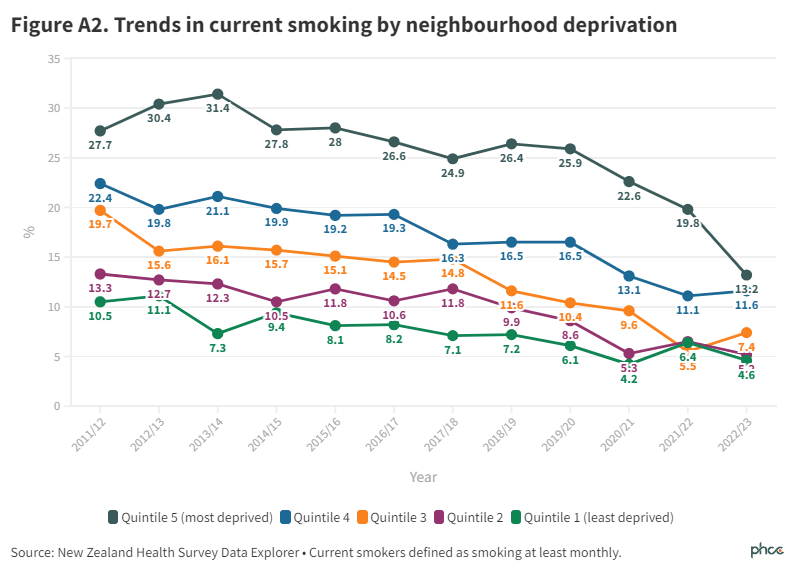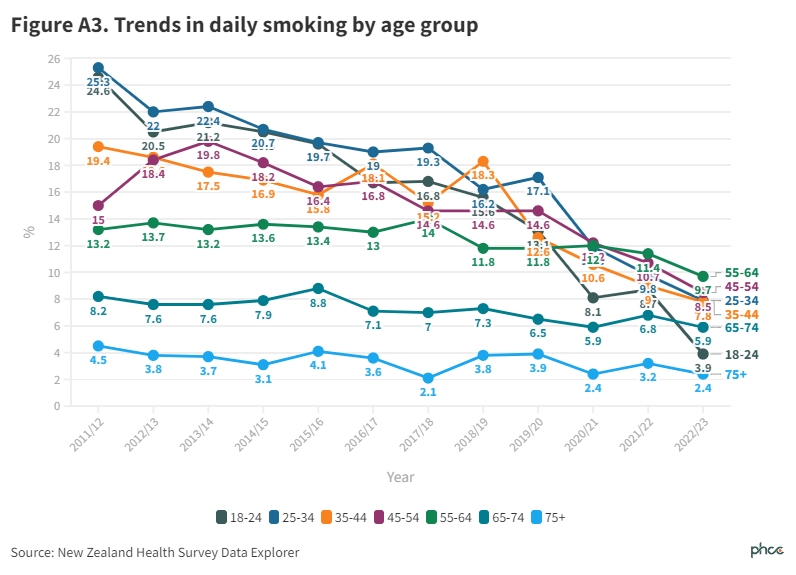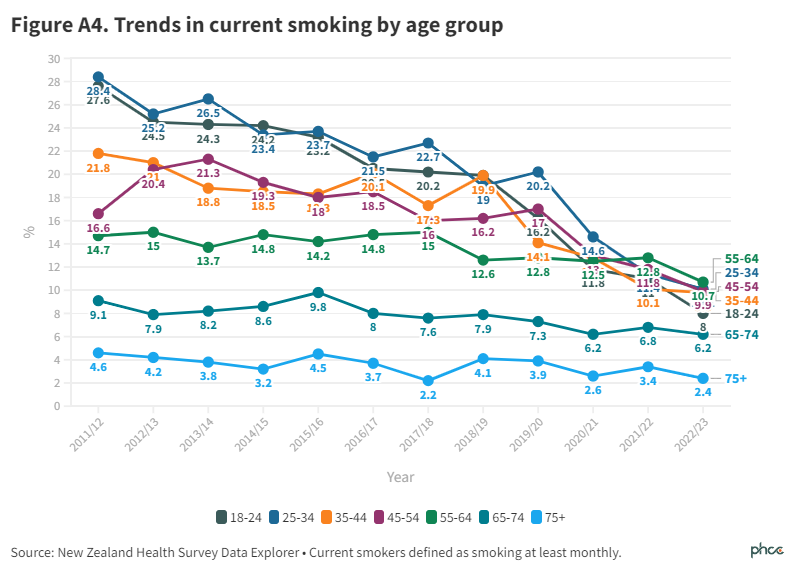Summary
New Zealand Health Survey data for 2022/2023 were released today. Daily and current smoking prevalence decreased, compared to 2021/22. However, smoking prevalence remains unacceptably high among Māori and people experiencing higher levels of deprivation.
The findings support implementing the key smokefree measures included in the Smokefree Legislation, which the government proposes repealing.
Smoking is the single greatest cause of preventable disease and death in Aotearoa New Zealand. Previous analyses of the New Zealand Health Survey (NZHS) revealed a steady decline in current and daily smoking prevalence from 2011/12 to 2019/20 with a greater rate of decline between 2019/20 and 2021/22. However, large inequities in smoking by ethnicity and socio-economic status (SES) persisted. In addition, a substantial proportion of young people smoked in 2021/22.
In December 2021, the government introduced a comprehensive Smokefree Aotearoa Action Plan and, in December 2022, passed legislation to implement three key measures:
- Greatly reduce the number of retail outlets selling smoked tobacco products
- Reduce the nicotine content of tobacco products to non-addictive levels
- Introduce a smokefree generation policy to protect young people from addiction to smoking.
Further details about the Action Plan and Smokefree legislation and information on the repeal are on our website.
In November 2023, Aotearoa’s new coalition government announced its intention to repeal the Smokefree Legislation.
This briefing summarises key findings on smoking prevalence from the 2022/23 NZHS. Findings relating to prevalence and trends in vaping will be reported in a future briefing.
About the New Zealand Health Survey
The NZHS is an annual nationally representative population survey. It has run since 2011/12 and aims to sample around 14,000 adults aged 15 years and over every year. Full details of the methods and a methodology report are available on the Ministry of Health website. Data used in this Briefing are sourced from the NZHS data explorer.
Key findings
Overall smoking prevalence trends
As outlined in Figure 1, daily smoking prevalence in 2022/23 was 6.8% (95%CI: 6.1-7.5%) which equates to an estimated 284,000 New Zealanders smoking daily. Current smoking prevalence (defined as smoking at least monthly) was 8.3% (95%CI: 7.5-9.2%).
The reductions in daily and current smoking equate to absolute falls of less than 2%, compared to 2021/22. These are similar to the annual reductions seen in the previous two surveys.
Smoking prevalence and trends by ethnicity
Gross inequities in smoking persist for Māori (Figure 2), who make up 38% of people who smoke daily and 36% of people who smoke currently.
17.1% of Māori smoke daily (estimated to be 108,000 people). Compared to 2021/22, daily smoking rates have dropped by 4.2% in absolute terms. Similar trends were seen for Māori who currently smoke (Figure A1 in the Appendix) though the drop in prevalence in the 2022/23 survey was less pronounced for this measure (from 22.3% to 20.2%, 2.1% absolute drop).
While the decreases in daily smoking prevalence for Pacific people look very promising (Figure 2), further exploration of this data is required as the Pacific sample sizes are very small and may result in fluctuations in prevalence from survey to survey. The large reduction in daily smoking prevalence from 18.1% in 2021/22 to 6.4% in 2022/23 was not accompanied by an increase in the quit rate* (25.7% in 2021/22 and 26.0% in 2022/23), or the prevalence of ex-smokers (reduced from 20.5% to 16.9%), as would be expected to accompany a genuine large fall in smoking prevalence.
Smoking prevalence and trends by neighbourhood deprivation
As outlined in Figure 3, although there was a large fall in smoking prevalence among the most deprived quintile, inequities persist between the highest and lowest quintiles of neighbourhood deprivation. As with data from Pacific people, further investigation of the results may be needed regarding the 8.4% absolute reduction in daily smoking rates for people included in Quintile 5. This reduction in daily smoking prevalence was not accompanied by an increase in the quit rate* (15.1% in 2021/22 and 17.4% in 2022/23) or by an increase in the prevalence of ex-smokers (reduced from 29.0% to 27.7%).
Patterns in current smoking were similar to daily smoking and are presented in Figure A2 in the Appendix.
Smoking prevalence and trends among young people
Current and daily smoking prevalence among 18 to 24 years olds decreased between 2021/22 and 2022/23 (Figure 4) continuing long-standing declining trends. Daily and current smoking rates by all age groups are in shown in Figures A3 and A4 of the Appendix. Declines in smoking among older age groups have been much less pronounced than for people aged 18-14.
Conclusions
Although smoking prevalence has declined, persisting inequities between smoking prevalence among Māori and non- Māori mean stronger measures are urgently required. Evidence of continuing stark inequities means the need for new smokefree measures that will accelerate reductions in smoking prevalence among Māori and lower socioeconomic groups remains vital. Retaining and fully implementing the Smokefree Legislation measures will provide the best possible chance that the Smokefree Aotearoa goal is achieved equitably and as quickly as possible.
What is new in this Briefing
- The prevalence of daily smoking declined to 6.8% in 2022/23, representing an estimated 284,000 New Zealanders smoking daily.
- Substantial inequities in smoking exist. Māori daily smoking prevalence was 17.1% in 2022/23
- Inequities also persist between the highest and lowest neighbourhood deprivation quintiles, with a daily smoking rate of 10.1% for people in the lowest quintile.
Implications for public health practice and policy
- Without the measures outlined in the Smokefree Legislation, Māori will continue to be disproportionately burdened by smoking and the harms it causes.
- Public health practitioners should continue to advocate for the full implementation of Aotearoa’s Smokefree Legislation.
- The Government should recognise all people have a right to good health, implement the Smokefree Legislation as planned, and ensure smoking prevalence falls rapidly among all population groups.
*Quit rate is calculated by dividing the number of people who have quit smoking in the past 12 months by the number of people who smoke daily and who are still smoking daily plus the number of people who have quit smoking in the past 12 months.
Author details
Dr Janine Nip, Prof Richard Edwards, Dr Jude Ball, Prof Janet Hoek, Assoc Prof Andrew Waa
All authors are members of ASPIRE Aotearoa and the Department of Public Heath, University of Otago, Wellington
Appendix - Additional results
Current smoking (smoking at least monthly) trends across demographic catergories.
Smoking trends across all age categories


